
A drink is a liquid intended for human consumption. In addition to their basic function of satisfying thirst, drinks play important roles in human culture. Common types of drinks include plain drinking water, milk, coffee, tea, hot chocolate, juice and soft drinks. In addition, alcoholic drinks such as wine, beer, and liquor, which contain the drug ethanol, have been part of human culture for more than 8,000 years.

Horlicks is a malted milk hot drink developed by founders James and William Horlick. It was first sold as "Horlick's Infant and Invalids Food," soon adding "aged and travelers" to their label. In the early 20th century it was sold as a powdered meal replacement drink mix.

A churro is a fried-dough pastry—predominantly choux—based snack. Churros are traditional in Spain and Portugal, from where they originate, as well as the Philippines and Ibero-America. They are also consumed in the Southwestern United States, France and other areas that have received immigration from Spanish and Portuguese-speaking countries. In Spain, churros can either be thin or long and thick, where they are known as porras in some regions. They are normally eaten for breakfast dipped in champurrado, hot chocolate, dulce de leche or café con leche. Sugar is often sprinkled on top.

Milo is chocolate and malt powder that is mixed with hot water and milk to produce a beverage popular mainly in Oceania, South America, South-east Asia and certain parts of Africa. Produced by Nestlé, Milo was originally developed by Australian inventor Thomas Mayne in 1934. It is marketed and sold in many countries.

Champurrado is a chocolate-based atole, a warm and thick Mexican drink, prepared with either masa de maíz , masa harina, or corn flour ; piloncillo; water or milk; and occasionally containing cinnamon, anise seed, or vanilla. Ground nuts, orange zest, and egg can also be employed to thicken and enrich the drink. Atole drinks are whipped up using a wooden whisk called a molinillo. The whisk is rolled between the palms of the hands, then moved back and forth in the mixture until it is aerated and frothy.

Abuelita is a brand of chocolate tablets, syrup, or powdered mix in individual packets, made by Nestlé and used to make Mexican-style hot chocolate, also known as chocolate para parties. It was originally invented and commercialized in Mexico since 1939, by Fábrica de Chocolates La Azteca. The name is an affectionate Spanish word for "grandma". Since 1973, Mexican actress Sara García has been the image for the brand before it was acquired by the Swiss company in the 1990s.
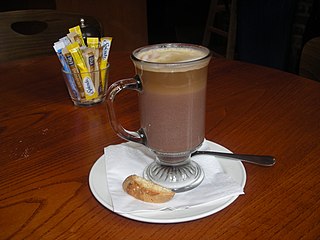
A caffè mocha, also called mocaccino, is a chocolate-flavored variant of a caffè latte. Other commonly used spellings are mochaccino and also mochachino. The name is derived from the city of Mocha, Yemen, which was one of the centers of early coffee trade.

A buñuelo is a fried dough ball. It is a popular snack in Argentina, Belize, Bolivia, Colombia, Cuba, Ecuador, El Salvador, Greece, Guam, Guatemala, Italy, Israel, Mexico, Africa, Nicaragua, Panama, the Philippines, Puerto Rico, Spain, Turkey, Uruguay, and Venezuela. It is traditionally prepared at Christmas, Ramadan, and among Sephardic Jews at Hanukkah. It will usually have a filling or a topping. In Mexican cuisine, it is often served with a syrup made with piloncillo.
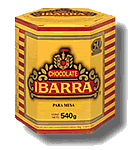
Ibarra is a brand of Mexican chocolate para mesa produced by the company Chocolatera de Jalisco of Guadalajara, Jalisco, Mexico. The company manufactures other chocolate products, but Ibarra table chocolate is its best-known product, with presence throughout Mexico as well as international markets, mainly in the Americas, but also in parts of Europe. It is often found in gourmet shops.
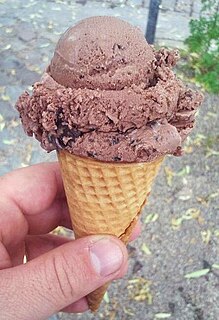
Chocolate ice cream is ice cream with natural or artificial chocolate flavoring. Chocolate is the second most common flavor of ice cream in the United States, after vanilla.
The Tunda is a myth of the Pacific coastal region of Colombia and Ecuador, and particularly in the Afro-American community of the Chocó department, about a shapeshifting entity, resembling a human female, that lures people into the forests and keeps them there.
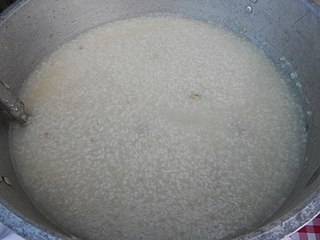
Lugaw, also spelled lugao, is a Filipino glutinous rice gruel or porridge. It is an umbrella term that encompasses various dishes, both savory and sweet. In Visayan regions, savory lugaw are collectively referred to as pospas. Lugaw is widely regarded as comfort food in the Philippines.

A molinillo is a traditional turned wood whisk used in Latin America, as well as the Philippines, where it is also called a batirol or batidor. Its use is principally for the preparation of hot beverages such as hot chocolate, atole, cacao, and champurrado. The molinillo is held between the palms and rotated by rubbing the palms together; this rotation creates the froth in the drink. This process is the subject of a popular children's nursery rhyme in Mexico.
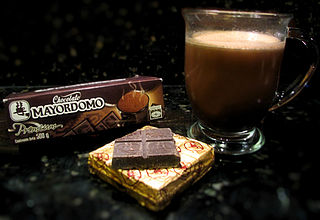
Mayordomo or Chocolate Mayordomo is a brand of Mexican chocolate para mesa produced by the company Chocolate Mayordomo De Oaxaca, S. De R.L. De C.V., and based in Oaxaca, Oaxaca, Mexico. The company manufactures mole sauce in addition to table chocolate.
The chocolate industry in the Philippines developed after introducing the cocoa tree into Philippine agriculture. The growing of cacao or cocoa boasts a long history stretching from the colonial times. Originating from Mesoamerican forests, cacao was first introduced by the Spanish colonizers four centuries ago. Since then the Philippine cocoa industry has been the primary producer of cocoa beans in the Southeast Asia. There are many areas of production of cacao in the Philippines, owing to soil and climate. The chocolate industry is currently on a small to medium scale.

Tsokolate, also spelled chocolate, is a native Filipino thick hot chocolate drink. It is made from tabliya, tablets of pure ground roasted cacao beans, dissolved in water and milk. Like in Spanish and Latin American versions of hot chocolate, the drink is traditionally made in a tsokolatera and briskly mixed with a wooden baton called the molinillo, causing the drink to be characteristically frothy. Tsokolate is typically sweetened with a bit of muscovado sugar, and has a distinctive grainy texture.
Pastil or pastel, is a Filipino packed rice dish made with steamed rice wrapped in banana leaves with dry shredded beef, chicken, or fish. It originates from the Maguindanao people and is a popular cheap breakfast meal in Mindanao, especially among Muslim Filipinos. Pastil is also known as patil, patel, patir, or pater in Maranao; and paster in Iranun.
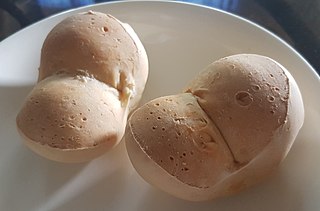
Pan de monja, better known as monáy, is a dense bread roll from the Philippines made with all-purpose flour, milk, and salt. It has a characteristic shape, with an indentation down the middle dividing the bread into two round halves. It is a common humble fare, usually eaten for merienda with cheese or dipped in hot drinks.


















